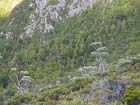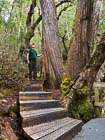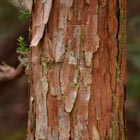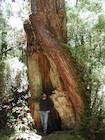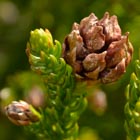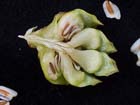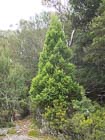Conservation Status

Athrotaxis selaginoides
D. Don 1838
Common names
King Billy pine; see "Remarks" for a digression on this rather unusual name. Some proper British authorities refer to the species as "King William pine."
Taxonomic notes
Syn: A. alpina Van Houtte ex Gord. (Silba 1986).
Description
Trees to 30 m tall and 150 cm dbh, usually with a single straight trunk but often twisted and sometimes multistemmed in open sites; forms a krummholz at alpine elevations. Bark orange-red, slightly furrowed, exfoliating in long strips, soft and spongy. Crown in forest trees very onical, strongly resembling the crowns of young Sequoiadendron, which this species strongly resembles in architecture and in bark characters. Foliage-bearing twigs numerous, mostly alternate, spreading, covered with stiff, spreading leaves; ultimate branchlets thick, variable in length, mostly persistent. Leaves helically arranged in ranks of 5, 7-18 × 3-4 mm, decurrent at base but spreading abruptly from the twig, keeled, apex acute and incurved; yellow-green; stomata primarily in two bands on the adaxial face. Pollen cones terminal, the bases surrounded by dwarfed leaves, 4-5 mm long, yellow turning brown, comprised of ca. 15 helically arranged narrow-triangular microsporophylls on short pedicels. Seed cones terminal, solitary, on a peduncle 2-3 mm. long, globose, 15-25 mm diameter, orange turning brown, opening widely at maturity; scales 20-30, helically arranged, thin-woody, triangular. Seeds 40-60 per cone, obovate, 2-3 mm long, with 2 narrow wings (Farjon 2010; pers. obs. in Tasmania, March 2015). See García Esteban et al. (2004) for a detailed characterization of the wood anatomy.
Distribution and Ecology
Australia: Tasmania: in mountain regions of the central plateau, extending almost to the West coast (Newbury [no date]), at 400-1120 m elevation (Farjon 2010). Highly detailed maps of the species' distribution, including inventory of dieback areas, have been prepared by the Tasmania Parks & Wildlife Service, but appear not to have been published (on display at Cradle Mountain visitor center, March 2015).
Species distribution. Data sources include Atlas of Living Australia (2019) and Conifers of the World (accessed 2019.07.16). Point data colors denote coordinate uncertainty: blue <50m, purple 50-1,000m, orange 1,000-10,000m, yellow not stated.
A. selaginoides is usually found on wet, talus or peat soils from transitional forests at elevations above Eucalyptus woodland, on up into the alpine; it generally has predominance at lower elevations compared to Athrotaxis cupressoides, with which it commonly shares subalpine habitat. Other common associates include Nothofagus cunninghamii, N. gunnii, Richea scoparia, R. pandanifolia, Diselma archeri, Pherosphaera hookeriana, Phyllocladus aspleniifolius, and various species of Eucalyptus, Atherosperma, Telopea, Orites, and Melaleuca (Farjon 2010). The species is primarily associated with the Athrotaxis selaginoides-Nothofagus gunnii short rainforest, Athrotaxis selaginoides rainforest, and Athrotaxis selaginoides subalpine scrub vegetation communities; it is also a component of the alpine coniferous heathland, Athrotaxis cupressoides rainforest, highland low rainforest and scrub, highland rainforest scrub with dead Athrotaxis selaginoides, Lagarostrobos franklinii rainforest and scrub, and Nothofagus gunnii rainforest and scrub vegetation communities (Kitchener and Harris 2013).
King Billy Pine has been listed as endangered under Australia's Environment Protection and Biodiversity Conservation Act of 1999 (Porfirio et al. 2014). The species does not get along well with humans, as shown by its responses to fire and climate change.
This is one of the least fire-adapted conifers and tends to disappear from the landscape in areas subject to fire. The fire regime during the early phases of European settlement of Tasmania (1897-98 was a particularly extreme event) resulted in loss of large areas of rainforest and alpine vegetation within the species' range (Marsden-Smedley 1998; Kirkpatrick and Dickinson 1984a, 1984b, as cited by Cullen 1991). It has been estimated that 30% of former A. selaginoides forest has been lost to fire (Brown 1988, cited by Kitchener and Harris 2013). As an example, Athrotaxis selaginoides–Nothofagus gunnii short rainforest once covered most of the east-facing slopes between Mount Dundas and Mount Read, but nearly half of these stands have been burnt (Kitchener and Harris 2013).
The likely responses of King Billy pine to global climate change have been investigated using a species distribution model (Porfirio et al. 2014). The model used MaxEnt, a widely used model building application, along with bioclimatic variables representing annual trends, seasonal trends, and extreme or limiting environmental factors; the variables were selected to explain more than 90% of the variance in the observed species distribution (based on 642 herbarium records). The climate variables were annual mean temperature, temperature seasonality, temperature annual range, annual precipitation, annual mean radiation, radiation seasonality, annual mean moisture index, and highest period moisture index. Future climate projections were derived from six global climate models that are widely used in global climate change studies. All models show substantial reductions in Athrotaxis selaginoides distribution under future climate (2070-2099) scenarios; an example comparison is shown below (current distribution on left; forecast future distribution on right).
 |
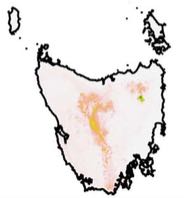 |
| 2014 |
2070-2099 |
Graphics from Porfirio et al. (2014).
Hardy to Zone 8 (cold hardiness limit between -12.1°C and -6.7°C) (Bannister and Neuner 2001).
Remarkable Specimens
A variety of very large and tall trees have been measured. Trevor Hinchliffe in March, 2019 posted photos on Facebook of two trees, both over 200 cm dbh, in Cradle Mountain National Park. The larger one is shown in the photo at right. The tallest reported tree was 37.8 m (sine method using a laser) for a tree along the "King Billy Track" in Reynolds Falls Nature Recreation Area, measured in 2009 by Veronica Tyquin. The second-tallest reported tree was 26.5 m, also measured by Tyquin in 2009, in the Black Bluff Nature Recreation Area (Kouta Rasanen email 2019.03.08, reporting a 2010 email from Tyquin).
The oldest known specimens, 940 years, are documented in a tree-ring chronology covering the period 302-2008 (fully crossdated), collected in Cradle Mountain-Lake St. Clair National Park by K. J. Allen, V. C. Lamarche, and B. M. Buckley (doi.org/10.25921/gaex-dz66). The 940-year lifespan was shown in one living tree (1050-1989) and one dead sample (948-1887). This chronology was incorporated in a long-term streamflow reconstruction for Tasmania (Allen et al. 2015). Kathy Allen, primary author for this work, speculates that some trees are probably 2,000 years old (Rääbus 2017). The Australian authorities have substantially restricted sampling of live-tree material (Allen et al. 2017), so this may be the best maximum age estimate we are going to get.
Ethnobotany
The Tasmania Regional Forest Agreement finds that the species is currently used primarily as "craftwood", noting that "King Billy pine is a slow-maturing species too scarce to allow sustained harvest of commercial quantities. Most demand is being met by substitutes. Salvaged timber is being used only for high-value products" (Commonwealth of Australia 1999).
Those who can find it, will find the timber "very lightweight. The sapwood is yellow, heartwood is pink to reddish brown. It is very soft, fine textured with close prominent growth rings and is easily split. Seasons very readily with little shrinkage or distortion. It is very durable and rot resistant. It planes and cuts very well. Because of its softness it bruises easily. It has good bending properties. Uses: Boat building, joinery, shingles, sounding boards in musical instruments, vats. It can be turned, but because of its softness, it tears on end grain" (Newbury [no date]).
Waldheim, a historically significant lodge at Cradle Mountain National Park, was built of A. selaginoides by Gustav Weindorfer, an Austrian immigrant who played a key role in the protection and preservation of Cradle Mountain. The original structure was built in phases in the 1920's and 1930's and was derelict when restoration efforts began in the 1980's; accordingly, an accurate replica was built on the site, and is shown here.
The species has been important in dendroclimatic research. Allen et al. (2017) report their development of a 1,700-year chronology, based on both living and dead tree material collected by a variety of investigators. The species shows potential for long-term temperature reconstruction, and shows a significantly different temperature-growth relationship compared to Lagarostrobos franklinii, the most long-lived Tasmanian conifer, which grows nearby. Allen et al. (2017) also review earlier work with the species. Early dendrochronological use of the species was reviewed by Norton and Palmer (1992).
Observations
It can be readily seen at the principal National Parks within its range, of which the most accessible and probably the most remarkable is Cradle Mountain National Park. The trails behind Waldheim provide access to some of the finest surviving large, old specimens, while the hike up Cradle Mountain will turn up specimens of A. × laxifolia in various places.
Remarks
The epithet notes a similarity to the foliage of Selaginella.
The species was named for King Billy, also known as William Lanne (c.1835-1869), often described as the last full-blooded male Tasmanian native (McFarlane 2006, Tasmania Parks & Wildlife Service 2008), although some living Tasmanian natives dispute this. The Tasmanian settlers, who were predominately from the British Isles, committed one of the earliest recorded intentional acts of genocide toward the Tasmanian natives, attempting to exterminate them utterly during the Black War (ca. 1825-1832), and arguably succeeding; all living Tasmanians are of mixed aboriginal and European descent, and much of their culture, including their native languages, have been lost. The people responsible for this war were in large measure convicts, sent to Tasmania by the British authorities for criminal acts, including in many cases the political crime of supporting Irish independence from Britain. "King Billy" was (and is) the disrespectful Irish Catholic name for William III of England, who did much to maintain the Protestant Ascendancy in Ireland, which for a long time was the principal instrument of British oppression of Irish Catholics. Thus the term "King Billy", applied to William Lanne, simultaneously conveyed the Tasmanian colonists' low opinion of both their British gaolers and the native Tasmanians. I have not been able to find an explanation of why the name was applied to this species, but I have a suspicion that it was founded upon the lumber. Timber from King Billy pine superficially resembles that of Huon pine (Lagarostrobos franklinii), and the two species occur together. Huon pine has one of the most superior softwood lumbers in the world--beautiful, easily worked, strong, and highly decay-resistant. During the colonial period, logging of Huon pine was an important industry in Tasmania, continuing until it led to the commercial extirpation of the species. A tree of A. selaginoides in a Huon pine forest would have been an object of contempt due to its inferior timber, and thus the name "King Billy pine" may have been applied by the loggers to convey that feeling for the tree.
Citations
Allen, K. J., S. C. Nichols, R. Evans, E. R. Cook, S. Allie, G. Carson, F. Ling, and P. J. Baker. 2015. Preliminary December-January inflow and streamflow reconstructions from tree rings for western Tasmania, southeastern Australia. Water Resources Research 51(7):5487-5503. doi: 10.1002/2015WR017062
Allen, K. J., P. Fenwick, J. G. Palmer, S. C. Nichols, E. R. Cook, B. M. Buckley, and P. J. Bakera. 2017. A 1700-year Athrotaxis selaginoides tree-ring width chronology from southeastern Australia. Dendrochronologia 45:90-100.
Atlas of Living Australia. 2019. Australia Virtual Herbarium download. Results truncated to eliminate values with coordinate uncertainty of more than 10,000 m and redundant collections at a given point. https://doi.org/10.26197/5d2e25642a291, accessed 2019.07.16.
Brown, M. J. 1988. Distribution and conservation of King Billy Pine. Hobart: Forestry Commission.
Commonwealth of Australia. 1999. Tasmania. http://www.rfa.gov.au/rfa/tas/raa/soceco/ch6_4.html, accessed 2007.07.21, now defunct.
Cullen, Phil. 1991. Regeneration of Athrotaxis selaginoides and other rainforest tree species on landscape faces in Tasmania. Papers and Proceedings of the Royal Society of Tasmania 125:191-200.
Donn, David. 1838. Annals of Natural History 1:235. Available at Archive.org, accessed 2016.02.23.
Kirkpatrick, J. B. and K. J. M. Dickinson. 1984a. The impact of fire on Tasmanian alpine vegetation and soils. Australian Journal of Botany 32: 613-629.
Kirkpatrick, J. B. and K. J. M. Dickinson. 1984b. Vegetation of Tasmania (map). Hobart: Forestry Commission of Tasmania.
Kitchener, Anne, and Stephen Harris (eds.). 2013. From forest to Fjaeldmark: descriptions of Tasmania's vegetation. 2013. http://dpipwe.tas.gov.au/conservation/flora-of-tasmania/from-forest-to-fjaedlmark-descriptions-of-tasmanias-vegetation-(edition-2), accessed 2016.02.26.
Marsden-Smedley, J. B. 1998. Changes in southwestern Tasmanian fire regimes since the early 1800s. Papers and Proceedings of the Royal Society of Tasmania 132:15-29.
McFarlane, I. 2006. William Lanne(y). www.utas.edu.au/library/companion_to_tasmanian_history/L/William%20Lanne.htm, accessed 2012.11.23.
Newbury, Keith. [no date]. King William Pine. http://home.vicnet.net.au/~woodlink/kingbill.htm, accessed 2001.07.15, now defunct.
Porfirio, L. L., R. M. B. Harris, E. C. Lefroy, S. Hugh, S. F. Gould, G. Lee, N. L. Bindoff, and B. Mackey. 2014. The use of species distribution models in conservation planning and
management under climate change. PLoS ONE 9(11): e113749. doi:10.1371/ journal.pone.0113749.
Rääbus, Carol. 2017.10.06. 2,000-year-old King Billy pines reveal Tasmania's climate and fire history. ABC Radio Hobart. https://www.abc.net.au/news/2017-10-07/king-billy-pines-reveal-tasmanias-history/9022430, accessed 2019.03.08.
Tasmania Parks & Wildlife Service. 2008. Native conifers of Tasmania. http://www.parks.tas.gov.au/index.aspx?base=3240" target="_blank">www.parks.tas.gov.au, accessed 2012.11.23, now defunct.
See also
Boland et al. (1985), pp. 66-67.
Brown, M.J. 1987. Conservation of King Billy Pine. Project 66. Project Report to World Wildlife Fund, Australia.
Brown, M.J. 1988. Distribution and Conservation of King Billy Pine. Tasmania: Forestry Commission.
Darby, A. 1994. Tasmania's pencil pine threatened by fungus [new root rot fungus suspected of killing species in their only habitat, around the Pine Lakes region on Tasmania's central plateau. Quarantine area declared around this habitat]. The Age, 1994.07.28: 8.
Elwes and Henry 1906-1913 at the Biodiversity Heritage Library. This series of volumes, privately printed, provides some of the most engaging descriptions of conifers ever published. Although they only treat species cultivated in the U.K. and Ireland, and the taxonomy is a bit dated, still these accounts are thorough, treating such topics as species description, range, varieties, exceptionally old or tall specimens, remarkable trees, and cultivation. Despite being over a century old, they are generally accurate, and are illustrated with some remarkable photographs and lithographs.
Farjon 2005.
Tasmania Forestry Commission. 1987. Management policy for King Billy pine. Hobart: Forestry Commission.
Threatened Conifers of the World.
